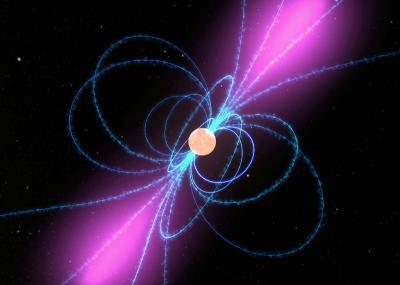Physical science is not immune. String Theory put theory in the name, so it gets to skate on the edges of truth, but theoretical physicists are trying to recapture the Golden Age of the 1930s, plus write a bestselling book. Astrophysics should know better. Yet many have still used the word theory to describe the "glitch" and "wobble" detected among pulsars, despite having no basis for it.
A pulsar emits a rotating beam of electromagnetic radiation, which can be detected by powerful telescopes as it sweeps past the Earth, rather like observing the beam of a lighthouse from a ship at sea. They rotate at extremely stable speeds, but occasionally they suddenly speed up in brief events described as 'glitches'. Pulsars can also spin at a slight angle so that their axis traces a cone shape, rather like the movement of a rugby ball which has been thrown slightly off balance - 'wobbling' at each end as it moves through the air.

Clouds of charged particles move along the pulsar's magnetic field lines (blue) and create a lighthouse-like beam of gamma rays (purple) in this illustration. Photo Credit: NASA
Mathematicians have used complex modelling to examine data for one particular pulsar which exhibits both 'glitching' and 'wobbling'. They found accepted theories which explain these phenomena conflict with one another - meaning they can't fit together to explain what is happening in the star. Which means they are not theories, they are hypotheses.
"There are a number of different theories around what causes pulsars to glitch and wobble," says lead researcher Dr Ian Jones. "Some center on the interaction between superfluid in a star's core and its crust - others suggest gravity from an orbiting planet is pulling the star back and forth.
"By studying this unusual pulsar, which glitches and wobbles, we have found that current theories contradict each other and therefore can't explain how both anomalies are occurring in the same star. As such, our results imply we are not seeing the whole picture and that there are errors in our current theories - suggesting a need to rethink what causes the anomalies."
Citation: Implications of Glitches in Pulsar Free Precession Candidates, Dr Ian Jones et al., Physical Review Letters https://journals.aps.org/prl/pdf/10.1103/PhysRevLett.118.261101





Comments